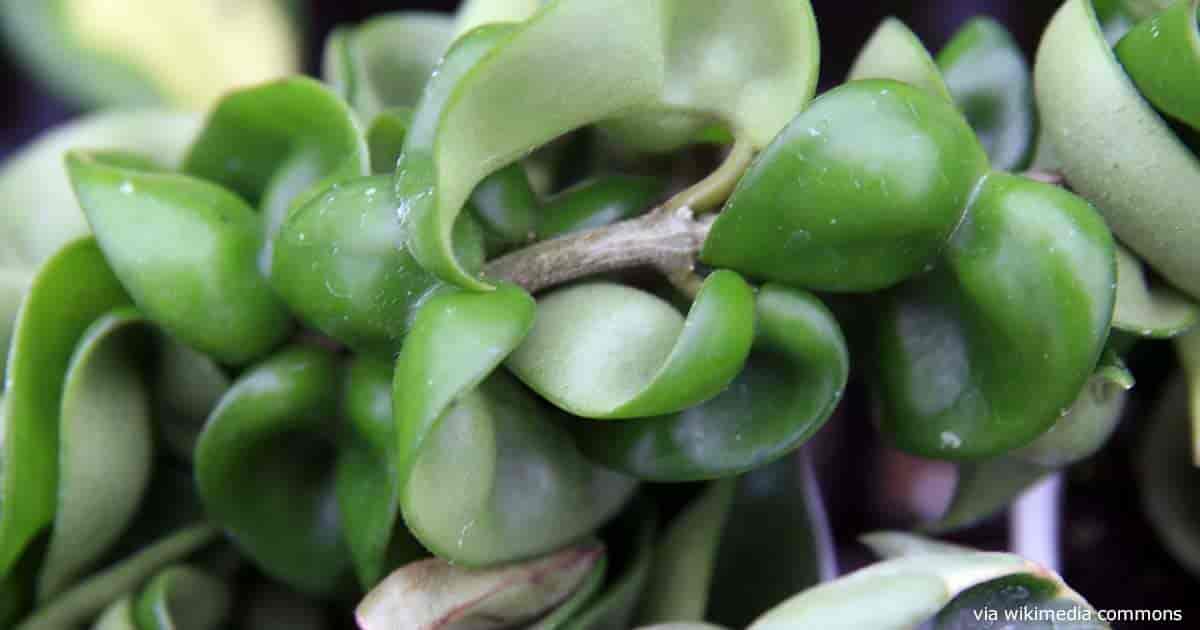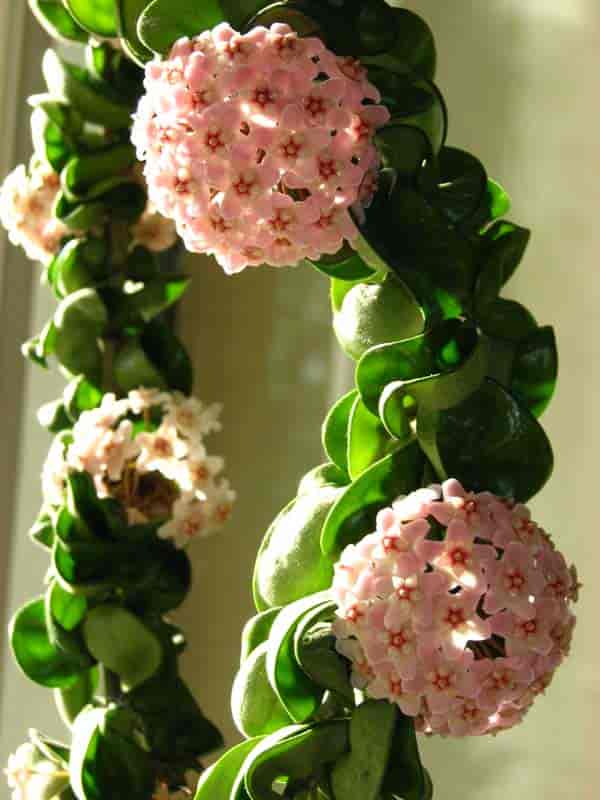The “Hindu Rope Plant” known also as Hoya compacta is a most interesting hanging plant. The rope Hoya features distinct, curling foliage setting it apart from the plant from which it came.
The name Hoya Carnosa is pronounced [HOY-yuh] [kar-NOE-suh] and includes a couple of popular Hoya varieties.

The “hindu rope hoya plant” is a mutation of the Wax Plant, known for its thick, waxy leaves. There is also a variegated curly leaf Hoya compacta.
This “curly Hoya” often is referred to as:
- Hoya compacta
- Hoya carnosa Compacta
- Hoya compacta ‘Krinkle Kurl’
- Porcelain Flower
- Hoya Hindu Quick Rope Care Tips
- Hoya Hindu Rope Care Tips
- How Big Does The Curly Hoya Compacta Grow?
- Is The Flowering and Fragrance Different Than The Regular Hoya Plant?
- What Type Of Lighting Does Hoya Compacta Like?
- Tips For Watering and Feeding The “Curly Wax Plant” Hindu Flower
- What Type Of Soil Is Best For The Hoya Rope Plant?
- Does The Curly Hindu Plant Need Any Special Grooming or Maintenance?
- Tips On Hindu Rope Plant Propagation
- What Pests or Disease Problems Does Rope Hoyas Encounter?
- Ways To Use Hindu Rope Hoya – Indoors or Outdoors
While Hoya carnosa compacta retains the waxy trait, the curled leaves are tightly packed and resemble rope. The unique look gives this plant its common name of the “Hindu Indian Rope Plant.”
These plants are native to Australia and Eastern Asia and are part of the Apocynaceae family. Commonly called the dogbane family, these plants often have milky latex sap or waxy leaves.
If you plan to place one of these delightful plants in your home, follow these Hindu rope care suggestions.
Hoya Hindu Quick Rope Care Tips
- Botanical Name: Hoya Compacta
- Common Name(s): Hindu Rope Hoya, Indian Rope Hoya, Krinkle Kurl
- Synonyms: Hoya carnosa compacta, Hoya compacta variegata
- Family & Origin: Apocynaceae family, native to Australia and Eastern Asia
- Growability: Easy to grow
- Grow Zone: USDA zones 10-12
- Size: Can grow up to 4 feet long
- Flowering: Produces small, star-shaped flowers in clusters
- Light: Bright, indirect light
- Humidity: Prefers high humidity
- Temperature: Ideal temperature range is 65-80°F
- Soil: Well-draining soil
- Water: Allow soil to dry out between waterings, water thoroughly
- Fertilizer: Use a balanced fertilizer every 2-3 months during growing season
- Pests & Diseases: Susceptible to mealybugs and spider mites, can also be affected by root rot if overwatered
- Propagation: Can be propagated through stem cuttings
- Plant Uses: Popular as a hanging plant, can also be trained to climb a trellis or support. Adds a unique texture to any indoor space.
Hoya Hindu Rope Care Tips
How Big Does The Curly Hoya Compacta Grow?
The curly hoya plant is slow-growing and recommended for USDA hardiness zones 10 – 12 for outdoor growth. When growing outdoors, the rope plant needs indirect sunlight.
When placed indoors, Hoyas are easy plants to care for. If hung from a basket, the stems may eventually reach lengths of several feet.

If grown around a wire loop, the length may depend on the size of the wire structure.
I’ve seen this curly succulent growing in hanging baskets where they “hang” 6’ feet or more.
Another Hoya with an interesting leaf shape is – Hoya Kerrii (Sweatheart Hoya)
Is The Flowering and Fragrance Different Than The Regular Hoya Plant?
The Hoya Hindu Rope produces flower clusters like the standard Hoya. The unique, star-shaped flowers form in clusters and have a pleasant aroma.
The Hindu Hoya Rope tends to bloom sporadically during the year. After the flowers bloom, do not rotate or move the rope plant, as the flowers may not survive the transition.
The rope Hoya plant also produces spurs, which are small, leafless stems. If you remove these spurs, the plant may not produce as many flowers in the coming years.

What Type Of Lighting Does Hoya Compacta Like?
For optimal growth, your Indian Rope hoya should get at least three to four hours of bright light near a window. Near a bright east or south-facing window is good.
If growing outdoors, it still requires plenty of bright light but should be placed in an area with indirect lighting.
Temperature Range: 65°- 80° degrees Fahrenheit and the plants can tolerate 50° degrees Fahrenheit without damage.

Hoya carnosa plants are native to warm, humid regions. While it can survive other environments, it grows best when kept out of the cold.
However, it can tolerate slightly cooler weather in the winter.
Tips For Watering and Feeding The “Curly Wax Plant” Hindu Flower
Your Hindu Rope plant needs regular watering throughout most of the year, especially during the active growing seasons.
Watering: Allow the surface of the potting soil to dry out between watering. Do not allow “rope curls” to sit in water.
In the winter, it can be kept a little dry. In fact, you should avoid overwatering and overfeeding in the winter.
You may also want to spray the leaves occasionally during the warmer months to help recreate humid conditions.
Fertilizing: Apply a balanced water-soluble liquid fertilizer every 2 to 3 months during the spring and summer growing season.
What Type Of Soil Is Best For The Hoya Rope Plant?
Rope plants grow well in a regular, well-draining potting soil. As a young rope hoya grows, you may need to repot the plant into larger containers.
A mature Hoya Rope plant should only be transplanted if you have no other option. Repotting may stress the roots of older plants.

When repotting, always use caution and protect the roots. The roots are typically tangled and should remain in the same condition when you place the plant in its new home.
Check out Hoya Soil: What Is The Best Soil For Growing Hoya Plants?
Does The Curly Hindu Plant Need Any Special Grooming or Maintenance?
Grooming is not necessary unless you want to control the growth of the stems. Whether growing from a hanging basket or around a wire loop, you can trim back the stems.
NOTE: If you plan to trim the stems, you should do so in the spring, giving the Hoya plenty of time to recover during the year.
Tips On Hindu Rope Plant Propagation
Just like the Hoya carnosa the rope Hoya variety is an easy plant to propagate.
Easily grow new plants from stem cuttings you take during active growth.

Remove the leaves from the lower portion of the cutting and allow it to dry. The milky latex should harden overnight.
- Place the cuttings in a small pot with a loose potting mix.
- Cover the potted plant with a clear plastic bag to help hold in the moisture.
- Keep the plants in a shaded area until they take root.
Related: Learn 3 Ways For Propagating Hoya Plants
What Pests or Disease Problems Does Rope Hoyas Encounter?
The main pests to worry about include mealybugs and spider mites. The waxy foliage provides the perfect hiding spot for these pests.
Regularly inspect the leaves and leaf nodes for any infestations. Use a Neem Oil spray to get into the curly leaves where the mealybugs are hiding.
Cleaning the leaves regularly may help deter the pests. It also helps to prevent dust from collecting.
The leaves of the Hoya Indian Rope are not considered toxic and should not pose a problem if ingested. More on the poisonous Hoya plant topic.
It is a safe houseplant to have around cats, dogs, and kids.
However, people with a latex allergy may experience a negative reaction when handling damaged leaves.

Ways To Use Hindu Rope Hoya – Indoors or Outdoors
The Hoya compacta is commonly grown indoors or on porches as a hanging plant. The heavy foliage and long stems keep it from easily growing upward.
If you prefer to grow this “curly plant” in a container, use a wire loop to support the stems.
